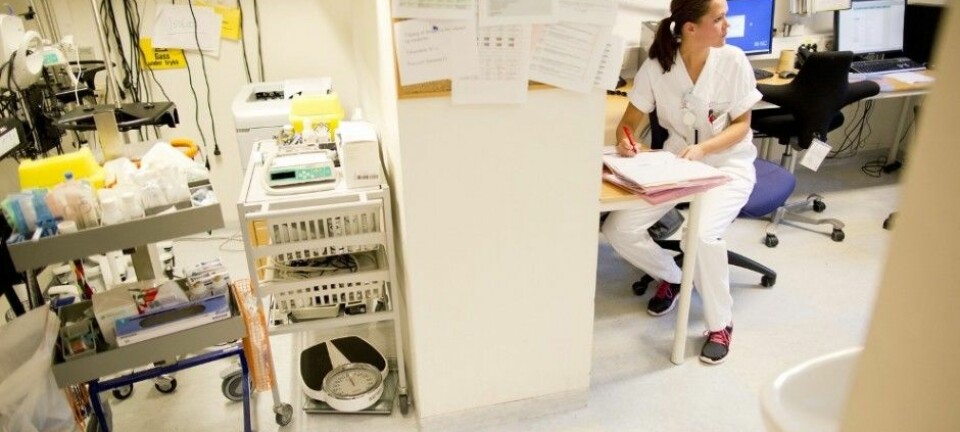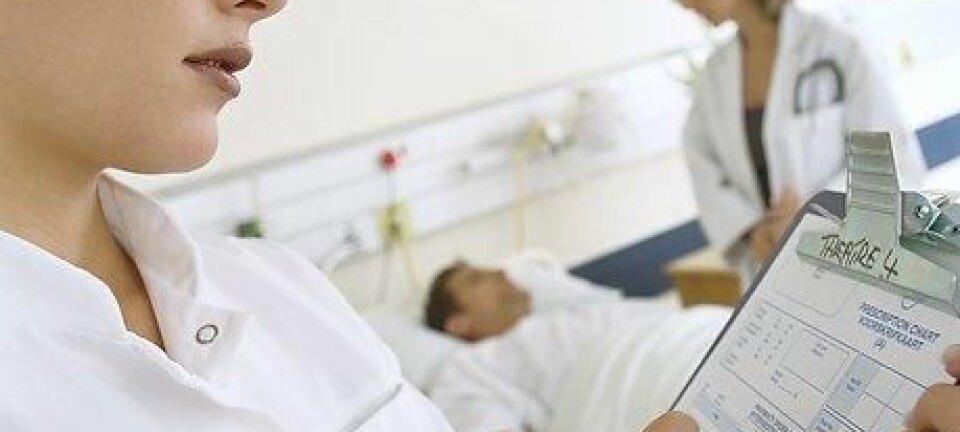
Life and death – just a regular Tuesday
For student nurses, interacting with patients is the most effective way to learn.
Anne Sophie stands in the pale and yellow locker room in the basement of the university hospital.
She is in the class of student nurses that I follow for two years during my research project on study life and strategies.
I’m there, when the next generation of nurses - like Anne Sophie - move from the classroom to the hospital ward. I’m there, when student life is just life, and when the responsibility of students becomes learning about other people’s suffering.
In those moments, when they must find the courage to act in the face of death, student nurses are often pushed to their personal and professional limits. In those moments, I found, future nurses are formed.
Personal experiences guided my research
Over days, weeks, months, and years, I observed Anne Sophie and her classmates. From the middle of their nursing education and until the first hectic and vulnerable period where they, as full-blown nurses, gain professional responsibility for their patients.
Through conversations (and more formal interviews) and the use of video diaries and field notes, I got close to students’ personal experiences of becoming a nurse.
It’s through these personal stories that I get an idea of what matters, when students navigate between the classroom and clinical practice – or ‘real life.’
I find that students’ relationships are important: be it with friends from class, supervisors, and teachers. But what determines student learning is meeting the patient. That’s when actual learning takes place.
Another person’s life in your hands
One day, towards the end of Anne Sophie’s last clinical residency, I meet her in the intensive care unit. Soon she would be able to call herself a nurse.
But Anne Sophie was very concerned with how she was going ‘to learn’ to behave around a patient when a situation develops in the “wrong direction.” When everything indicates that a disease is irreversible, when a patient’s life turns out completely different to what he or she had expected. Or when a life ends unexpectedly.
I watch as Anne Sophie approaches the patient she is responsible for on that particular day. The intensity of sights and smell is tremendous.
There is no doubt that this patient’s life is in danger. The naked body is covered with sheets, but they cannot hide the fact that this body is under extreme stress. Filled with drips and tubes, the patient is hooked up to several machines.
The medical ventilator is the most important, helping him breathe.
There is a smell of faeces and a recurring noise of alarms, violent coughing, and secretion. A myriad of doctors, specialists, nurses, physiotherapists, biomedical laboratory scientists, and hosptial porters come and go.
At times there is calm, other times it is hectic. But death seems to be lingering on this regular Tuesday. And in the middle of all this suffering, Anne Sophie has to learn to be a nurse.
“Where is the one who does everything right?”
Later, when I ask her how patients help shape the type of nurse she wants to be, Anne Sophie mentions one particular situation.
She is newly graduated and has just begun a 12-hour shift and describes in her diary how she tenderly approaches a patient to say good morning. The patient asks her: “Where is the one who does everything right?”
Despite the negative welcome and the reminder that the patient would rather see a more experienced nurse in the room, Anne Sophie stays in the room – and gradually, the patient silently accepts her presence.
Later, she notices that the tube to the ventilator is pulled out too far, and the fear of making mistakes with grave consequences reminds her of the seriousness of her responsibility.
A minute of fresh spring air
On the same day, Anne Sophie notices that the patient struggles with every breath – a struggle that she believes has gone on for too long.
The patient is paralysed from neck to toe, yet Anne Sophie still suggests they take the elevator down and go for a stroll in the fresh spring air.
Armed with a yellow post-it note with the direct number to the anesthesiologist, Anne Sophie pushes the bed out of the room, through the ward, and into the elevator.
From the hospital’s parking lot, they watch the blue sky and feel the spring air. After just a minute the patient wants to go back.
Inside the ward they are met by the patient’s family, and Anne Sophie leaves them alone for a moment. As they come back to say goodbye to her, she notices the tears in their eyes.
She doesn’t know whether their tears are caused by the realisation that their father and husband will never be able to walk out of the ward himself, or by the joy of knowing that for the first time in a long time, he experienced something other than a noisy hospital ward.
A trembling nurse’s heart
Back in the patient’s room, Anne Sophie reaches for the patient’s hand. In that moment, he stutters: “Thanks – thank you so much.”
In that moment, Anne Sophie feels like he looks straight into her “trembling and newfangled nurse’s heart.” Right there, she realises what she can accomplish as a nurse – and that her professionalism makes a difference.
Anne Sophie’s story about the nurse’s heart is about seeing “the other” as a person and understanding how you can act as a nurse on the basis of that. But the story also shows how a brave choice – as well as mistakes – play an important role in learning.
For a researcher, Anne Sophie’s story is a personal reflection on becoming a healthcare professional. It is about the courage to witness the fragility and pain of patients and about trusting your own professional judgement.
Among the students in the class I followed, it was clear that the encounter with patients was what taught them the most in becoming a nurse.
Death is discussed – and felt
Students at professional programmes such as nursing face a double challenge of navigating both in the classroom and professional work environments – in this case, an intensive care unit.
The contrast is sharp and the conditions for learning are very different. In the classroom, death is discussed. With patients, it is felt.
In the classroom you can hide, but with patients, the responsibility is yours. You have to handle the pain, the suffering, and the grief. It is expected of you – also on regular Tuesdays.
Towards a new formation of character
The current education debate claims that the formation of character is missing in higher education, and the Danish ministry has suggested reviving the old days when philosophy was mandatory.
The suggestion is that a course with a carefully selected syllabus will prepare the next generation of professionals for the rapidly changing world.
My research, on the other hand, shows that it is the practical aspect of the nursing degree that is formative in itself.
It is clear that forming a professional life, where the responsibility for other peoples’ lives is paramount, cannot happen in the classroom alone.
The formation of character happens during meetings, like the one between Anne Sophie and her patient on a spring day. To engage in relations and handle difficult situations is what forms and shapes you as a student.
To experience the fragility of life helps student nurses become professionals.
-------------------
Read the Danish version of this story on ForskerZonen, part of Videnskab.dk
Translated by: Kristian Secher










